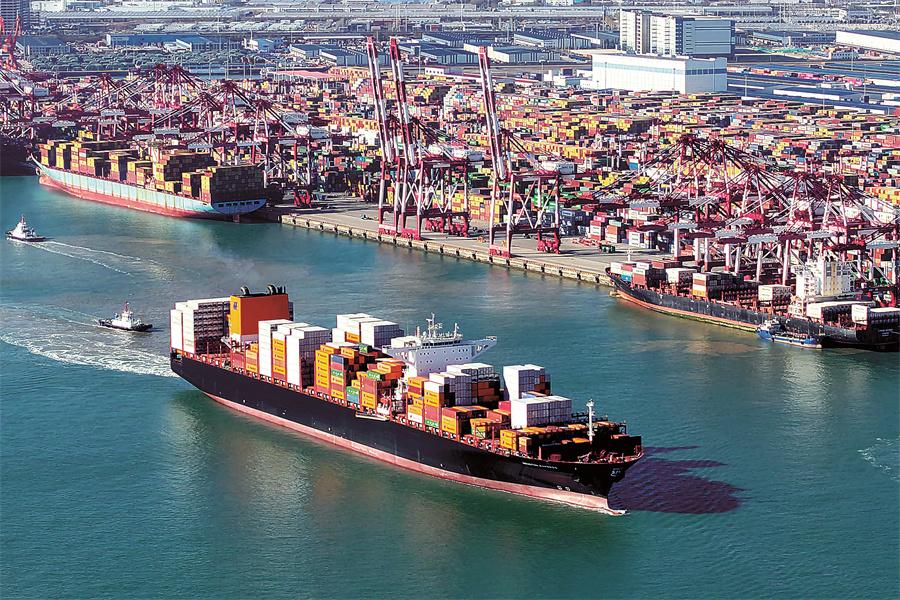May 16, 2025, 14:14

A container ship leaves Qingdao Port, Shandong province. [YU FANGPING/FOR CHINA DAILY]
Global Times-The latest projections from the Asia-Pacific Economic Cooperation (APEC) present a concerning outlook regarding the substantial negative impact of the rising tide of trade protectionism on the Asia-Pacific region. The situation underscores the growing urgency of strengthening multilateral cooperation to tackle various development bottlenecks within the region.
The APEC projected exports in the region would rise by only 0.4 percent this year, compared with 5.7 percent last year, in a regional trends analysis report released on Thursday at its 2025 meeting of ministers responsible for trade, Reuters reported. The organization also cut its regional economic growth forecast for this year to 2.6 percent from 3.3 percent previously.
These figures are stark reminders of the severe challenges posed by protectionist policies to the region's economic prospects. At a time when unilateralism and economic fragmentation threaten to undo decades of globalization, the region stands at a critical juncture.
The surge in unilateralist policies has wreaked havoc on the international trading order. Economies across the Asia Pacific, whether they are manufacturing powerhouses heavily reliant on exports or resource-based economies, have all felt the pinch. Developing economies, in particular, with their limited industrial diversity and technological capabilities, bear the brunt of these changes. Their exports have been hit hard by the deteriorating global trade environment, which could lead to a significant loss of economic momentum and further dampen regional growth.
Against this backdrop, the importance of multilateral cooperation has never been more pronounced. Deepening cooperation in the industrial, trade and supply chains has never been more urgent for countries in the Asia-Pacific region. By enhancing regional coordination and creating an efficient, open, and large-scale market, the region can restructure the trade network. In such a market, countries can leverage their resource endowments and industrial strengths, boosting overall competitiveness, effectively mitigating external risks and establishing a robust foundation for stable and sustainable economic growth.
The Asia-Pacific region, as a vital engine of the global economy, possesses immense development potential characterized by remarkable industrial complementarity and substantial consumption potential. In terms of consumption, the region's large population base and rising economic development levels have nurtured a consumer market of significant scale and vitality. Whether the region can effectively withstand the protectionist tide hinges on how well this consumption potential is harnessed.
China, with 1.4 billion people, stands as a prime example. As household incomes rise and consumption patterns evolve, the demand for high-quality goods and premium services continues to surge, making China one of the world's largest and most attractive consumer markets. Meanwhile, according to a projection by United Overseas Bank, 65 percent of the Southeast Asian population is expected to enter the middle class by 2030, representing one of the world's most promising consumption growth stories. These vibrant markets collectively represent an unparalleled consumption engine, a robust foundation for the establishment of a large-scale regional market.
On the journey of building such a regional market, China has been a steadfast supporter of multilateralism. In the face of unilateralism and protectionism, China's position remains firm: to defend international economic and trade rules and the multilateral trading system. The nation's stance is rooted in a profound understanding that an open, inclusive, fair, and free trading environment isn't just beneficial, but the linchpin for driving global economic growth, facilitating technological innovation and ensuring shared prosperity. This is why no matter how the international situation changes, China has always been a staunch defender of an open world economy.
China's actions speak louder than words. From ASEAN remaining China's largest trading partner for five consecutive years to the high-quality implementation of the Regional Comprehensive Economic Partnership; from steady progress in high-quality joint building of the Belt and Road to the accelerated development of pilot free trade zones and free trade ports, these facts all demonstrate China's commitment to high-level opening-up, which also offers the Asia-Pacific region greater opportunities through high-quality development.
Such endeavors stand in sharp contrast to the protectionist actions of some major economies. They exemplify China's sense of responsibility as a major power in promoting a more open, more inclusive, fairer and freer trading system throughout the region and the world.
Community login






Add a comment